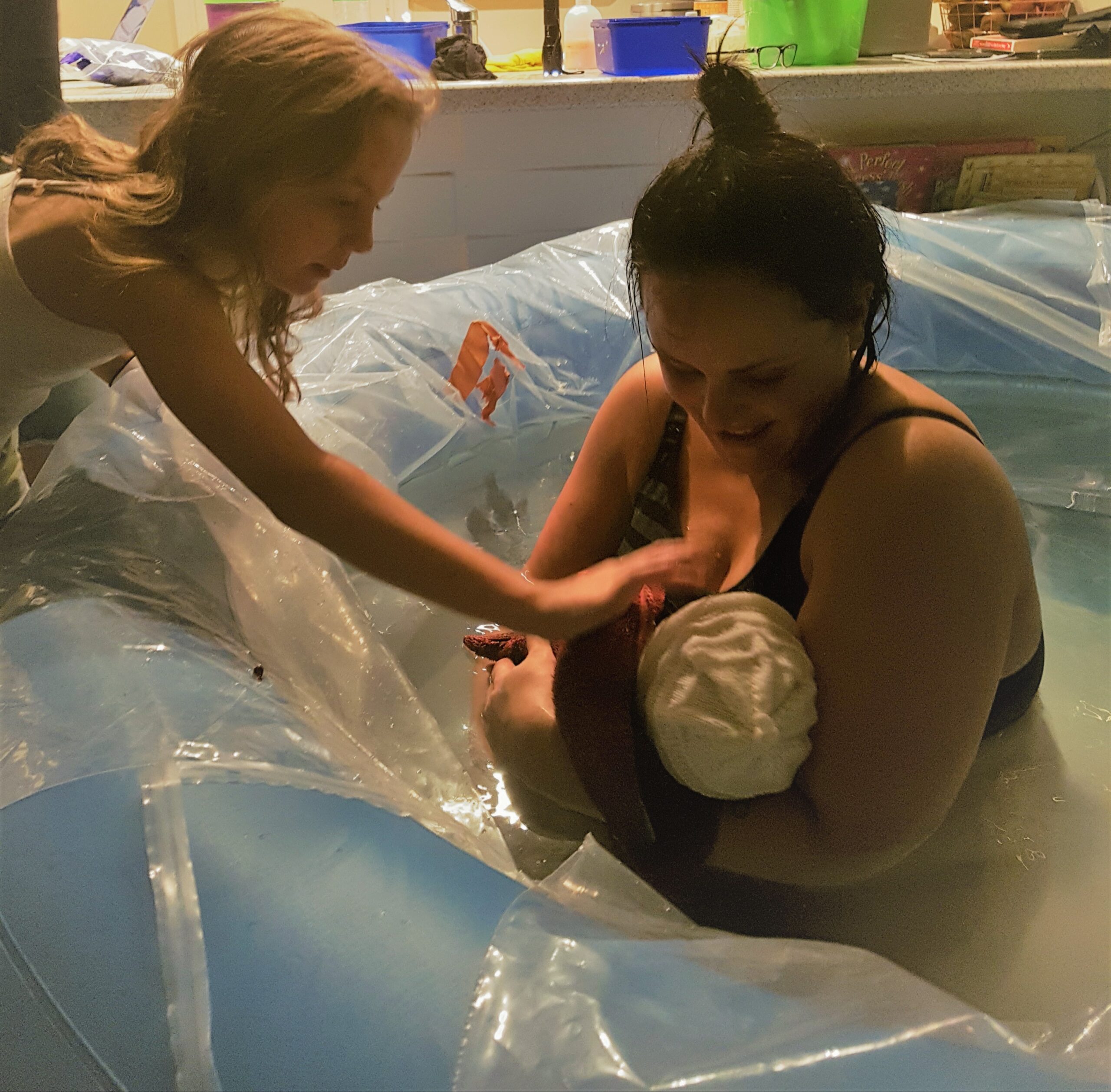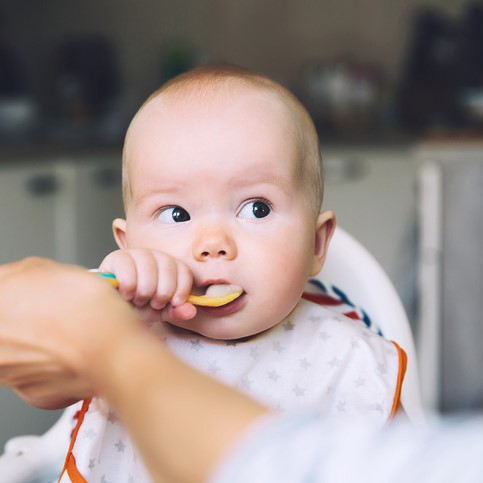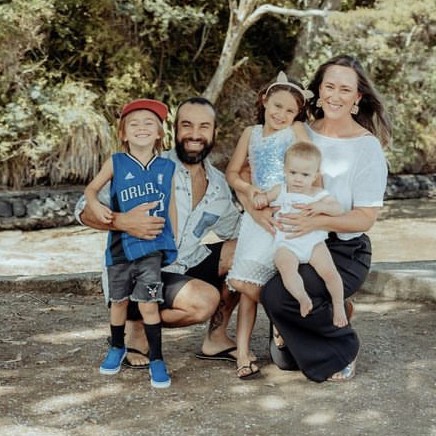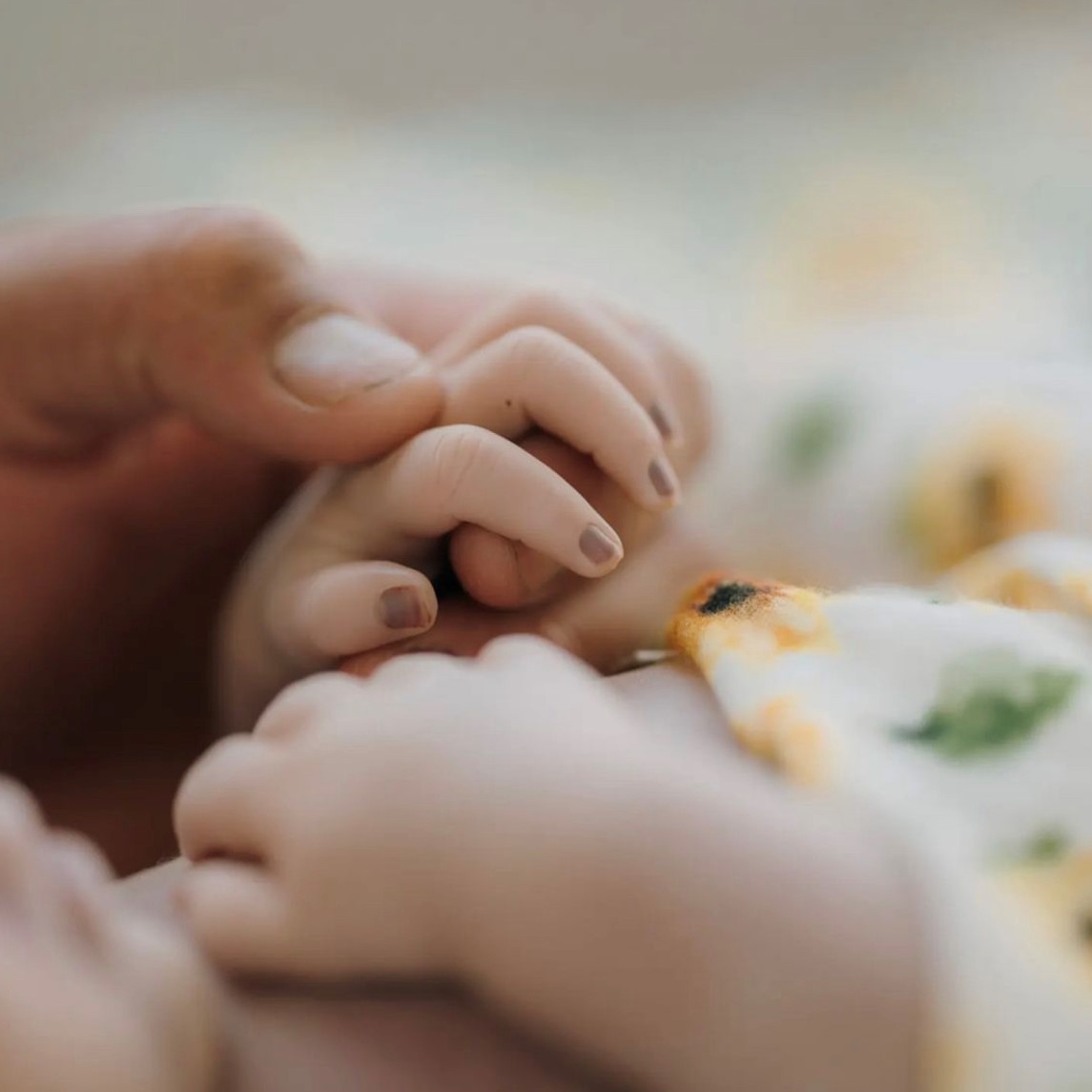Advice for Preparing for a VBAC with Birth Educator & Doula, Kristin White from Mama Rise

In light of April being Caesarean Awareness Month, a time to not only raise awareness about c-sections but to advocate for VBAC too, we spoke to Christchurch-based birth worker, Kristin White. Having had a hospital VBAC for her second baby and a home birth VBAC for her third, who better to talk to preparing for a vaginal birth after caesarean than this empowered and informed māmā of three?
Kia ora Kristin, can you start by introducing yourself? Tell us about where you live, who’s in your whānau and what you do for work.
I’m Kristin and I live in Christchurch, New Zealand. My whānau consists of me, my husband Gareth and our three daughters Izabela, Quinn and Mila, our very loved cats Billy and Coco, and our new addition a wee puppy, Frankie. I am a childbirth educator, birth trauma practitioner and doula.
Today we’re talking about vaginal birth after caesarean section (VBAC). You identify as a VBAC specialist. Can you tell us about your own births with your babies and how those experiences led you to be a birth worker in this space today?
My first daughter was born nearly 13 years ago via an emergency c-section. I was 24 at the time and while I believed I could birth naturally, my biggest focus was ‘I do not want to have a birth like my Mum did with me’ and it ended up being so much worse. I had a long labour (which is very normal for a first-timer), I was coping well and so was my baby. It wasn’t until my midwife suggested that I have some constant monitoring for ‘20 minutes’ that things turned. My midwife left me for two hours and I got so distressed being strapped to the bed. Before then, I had been active in my labour so this was not what I wanted. I had dilated to 9cms then went down to a 7 – this was when a c-section was called. My baby was not distressed and I know now that I should have been given more time. I then had things happen to me without consent and my bond with my new baby was so fractured. The day after my surgery, a doctor came to see me and standing at the end of my bed, without even examining me, told me “I recommend never trying a vaginal birth again, you’re just too small.” That one sentence was enough to convince me to prove him wrong, and so I did.
My second daughter was born six years later; a hospital VBAC. I was blessed to find a midwife that was fiercely supportive of my decision to have a VBAC, and at times she believed in me more than I believed in myself. It took me to my edges, made me push through all of my doubt, and surrender to the power that my body had. I had an obstetric appointment at some stage through my pregnancy where they made their recommendations to me – of which I declined most of them. I agreed to cordless constant monitoring because I wanted a water birth, but that was it. Looking back, I wish I had declined that too! As I was birthing my daughter, I vividly remember saying, “I am so excited” as everyone cheered me on and told me how much dark hair she had. I quickly birthed a beautiful, perfect, tiny, dark-haired baby girl and I have never been so proud of myself.
Our third daughter came along unexpectedly two years later. My midwife at the time suggested a homebirth, which at first I said a big fat ‘NO WAY’ to. But I decided to have an open mind and educate myself. After hearing other people’s birth stories, I thought ‘why can’t I do it too?’ At 16 weeks pregnant, I had decided to homebirth, much to my husband’s dismay: “You can’t do that, you’ve had a c-section, you need to be in hospital.” To which I replied, “This is what I am doing, you can come OR not.” He came and both of us had the most beautiful, powerful experience of our lives. Our midwife sat in the background, observing me only. I birthed my third daughter in the water, all by myself, in the comfort of my own home. We got Izabela up to come and meet her sister as soon as she was born and Quinn woke the following morning to her mama sitting on the couch with a baby. This birth is what made me realise that all women need to know how good birth can be.
What was the catalyst for your decision to have a VBAC the first time? How did you personally come to that decision?
1. I wanted to prove that doctor wrong and 2. I never ever wanted to experience losing control and autonomy in my body ever again!

The New Zealand College of Midwives supports vaginal birth after caesarean section (VBAC), stating that it is a safe option for the majority of birthing people. What are the benefits and risks of a VBAC?
The risk of a VBAC is uterine rupture. The risk after one c-section is approximately 0.5% and the risk after two c-sections is approximately 0.9-1.61%. These statistics come from large studies that included birthing people who laboured spontaneously, were induced or augmented – so these results are very skewed and not entirely accurate. Induction and augmentation will increase the risk of rupture, even in an unscarred uterus.
The benefits of a VBAC are plentiful. I always encourage birthing people to consider waiting for spontaneous labour because your chances of achieving your VBAC after spontaneous labour are much greater. It also means that your body is ready to give birth and your baby is ready for the outside world. Physiologically, this is more beneficial too because both mum and baby go through changes in the brain that prepare them for their journey together. A VBAC will also offer greater chances of bonding with your baby, more success with breastfeeding, and birthing people who have a VBAC generally report feeling much more satisfied with their birth experience – we can thank oxytocin for that!
When might a VBAC not be advisable?
There are very few reasons a VBAC would not be advised. Major complications such as placenta accreta (which is actually a risk associated with c-sections) would be a reason for a repeat c-section. I truly can’t come up with many more GENUINE reasons not to have a VBAC – because most ‘I’d advise against a VBAC’ reasons are fear-based.
What are the chances of someone being “successful” in having a VBAC in Aotearoa?
In New Zealand, about 10% of birthing people choose to have a VBAC and of that 10%, 70% will be successful (statistically).
Birth can be unpredictable. What factors can influence whether a VBAC is achieved or not?
Birth place, space and people. In my opinion, when planning for a VBAC a person should plan for a ‘normal vaginal birth.’ Choosing where to birth, what rules and boundaries you have around your birth space and who you’re inviting to your birth are so important.
- In a hospital setting, there will be rules and recommendations for VBAC people. I would advise researching these, to decide what you will accept and what you will decline; decide before birth day.
- Understand what constant fetal monitoring is – this has been directly linked to the rise in c-sections since its introduction in 1968, with no better outcomes for mothers and babies.
- Your support team need to be ready to advocate for you, protect your space and protect you; at times you may not be in a space to say ‘no’, but they can.
- Trust birth and allow it to unfold in its own time, this can take a lot of work prior to birth to gain back that trust in your body. Understand that birth is not linear and doesn’t have a set of rules it will follow. Birth itself is as unique as the birth giver.
View this post on Instagram
If someone is wanting to have a VBAC, where is the best place to start with preparation and planning?
There is a lot of information online but it can be very biased. VBAC Facts is an excellent online resource with loads of evidence-based information. Search for VBAC birth stories, read them, listen to them on podcasts, they are plentiful. Also, learn about normal physiological birth – I can’t stress this enough. Understanding birth will go in any birthing person’s favour but for a VBAC māmā, it is vital information.
Check out your DHB’s VBAC guidelines – these are available to the public, you can simply search for them online. Read through them and start thinking about how you feel about them.
Join the VBAC Support Aotearoa group on Facebook. This group is full of birthing people that are wanting to or who have had a VBAC. Read their stories, ask questions, and connect with people in your community. It is an amazing space.
You can also connect with me, even if just for a chat.
How important is it to process what happened in the caesarean birth before planning for the VBAC? What are some ways people can undertake this healing and reflection, either with a professional or on their own?
This is the most important part of the process. Unpacking your previous birth will be crucial in how you feel going into your VBAC. Knowing why your birth may have ended in c-section may release you from feelings of guilt, fear, and lack of belief in your body. This may then allow you to go into your next birth with a clean slate.
There are many birth trauma practitioners (including myself) available around New Zealand that offer 1:1 birth trauma sessions. You can find a list of practitioners here: Our Team | Healing Birth. Birth trauma practitioners understand birth, the hospital system, and can offer insight into ‘why’. Most offer in-person and Zoom sessions.
Alternatively, you could go via your GP and try to access free counselling sessions.
Let’s talk about the consultation process. What should birthing people be aware of when discussing their wishes for a VBAC with their LMC and/or obstetrician?
If they use terms like ‘allowed’, ‘good candidate’, ‘want to see you in labour by 41 weeks’, these are all red flags. No one gets to decide if you are allowed to have a VBAC except you. No one decides if you’re a good candidate except you. No one gets to decide when you go into labour except your body and your baby.
I had an experience when meeting midwives for my first VBAC with one midwife saying to me, “You will have to meet with an obstetrician to see whether or not you can have a VBAC.” I knew right then that there was no way this was my midwife! It is important to interview midwives until you find the right one that will 100% support you. Don’t stop until you find them!
You will be offered an obstetric consultation to discuss your birth options, where they will offer you their recommendations. Remember these are recommendations ONLY; you can decline anything you don’t feel comfortable with, including constant monitoring! Christchurch DHB guidelines suggest that intermittent doppler monitoring will suffice when having a VBAC.
A great question to ask any care provider is: How many uterine ruptures have you seen in your career with VBACs?
Can you explain what an ‘absolute risk’ is and why it’s important when making informed decisions about birth? Particularly in the context of uterine rupture, which is regarded as the main risk of a VBAC?
The relative risk of a uterine rupture after one c-section is approximately 0.5%.
The absolute risk is about putting that 0.5% risk into perspective. 0.5% in absolute terms means that 1 in 200 birthing people will experience uterine rupture or 50 in 10,000. I like to look at the risk in a different way; 199 birthing people won’t rupture or 9950 won’t rupture.
What advice do you have for birthing people about how to say ‘no’?
Remember that it is YOUR body. You do not have to let anything happen to it or let anybody touch you if it is not what you want. During pregnancy, tune into your body, really acknowledge how things make you FEEL and then do the same thing when a suggestion is made during birth: FEEL. You have every right to say ‘no’ to anything that you don’t feel comfortable with. If you would say ‘no’ during sex, you can say ‘no’ during birth.



